Raising Dogs the Hunter/Gatherer Way
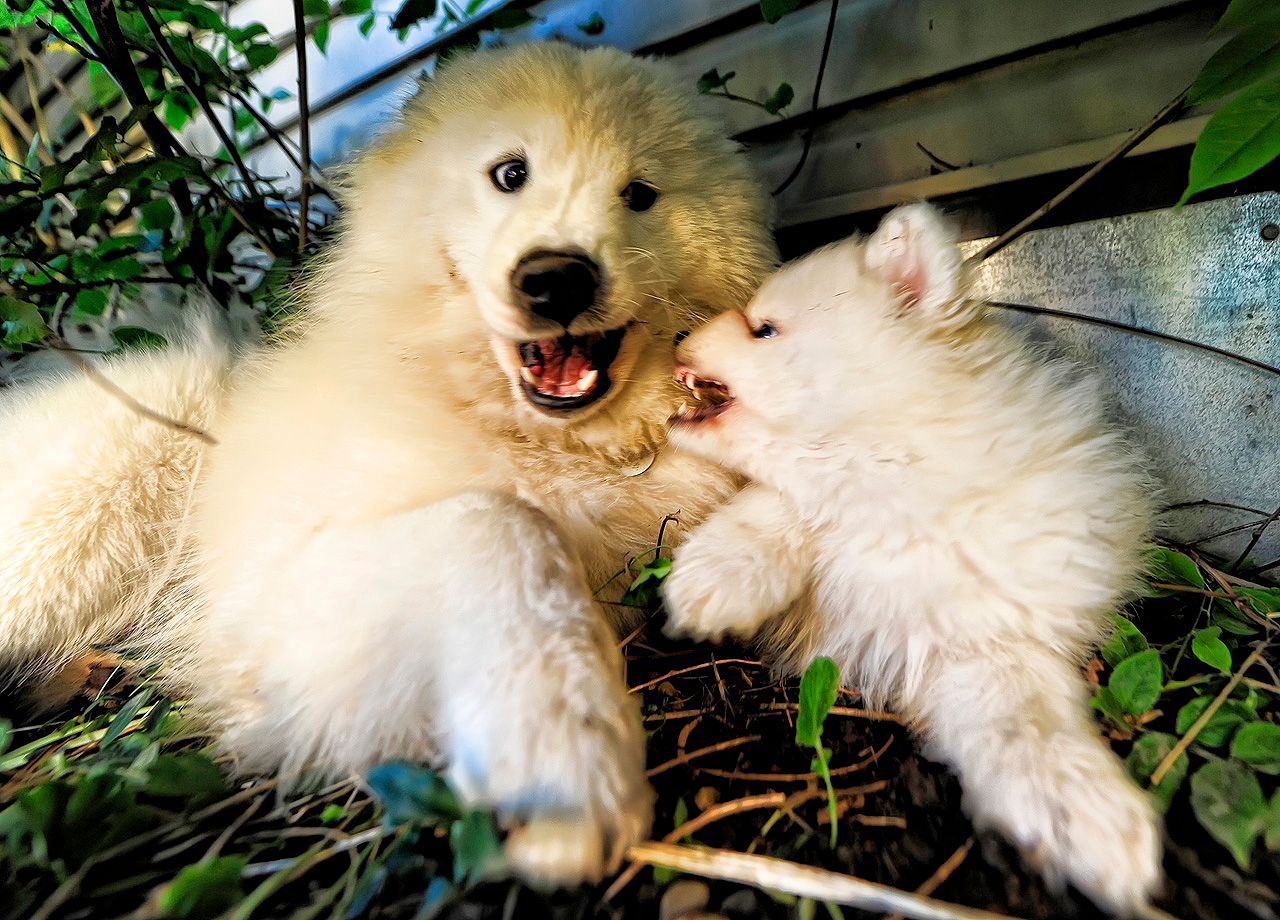
This post covers how we’ve been raising Jamie and Alice, especially in regard to training, or the lack thereof. It got a bit long, so here’s a summary:
- We’re raising Jamie and Alice with a daily emphasis on pack bonding, but no organized training of any kind.
- We’re happy with the results, but your mileage may vary and we don’t have any opinions about how you should raise your dogs.
- I found it interesting to learn in Jared Diamond’s latest book (The World Until Yesterday: What Can We Learn From Traditional Societies?) that the things we’re doing with Jamie and Alice are very similar to how certain hunter/gatherer societies raise children.
I’ve written this up because I know there are others who also are doing no formal training with their dogs, but nobody ever talks about that except as a “problem to be solved.”
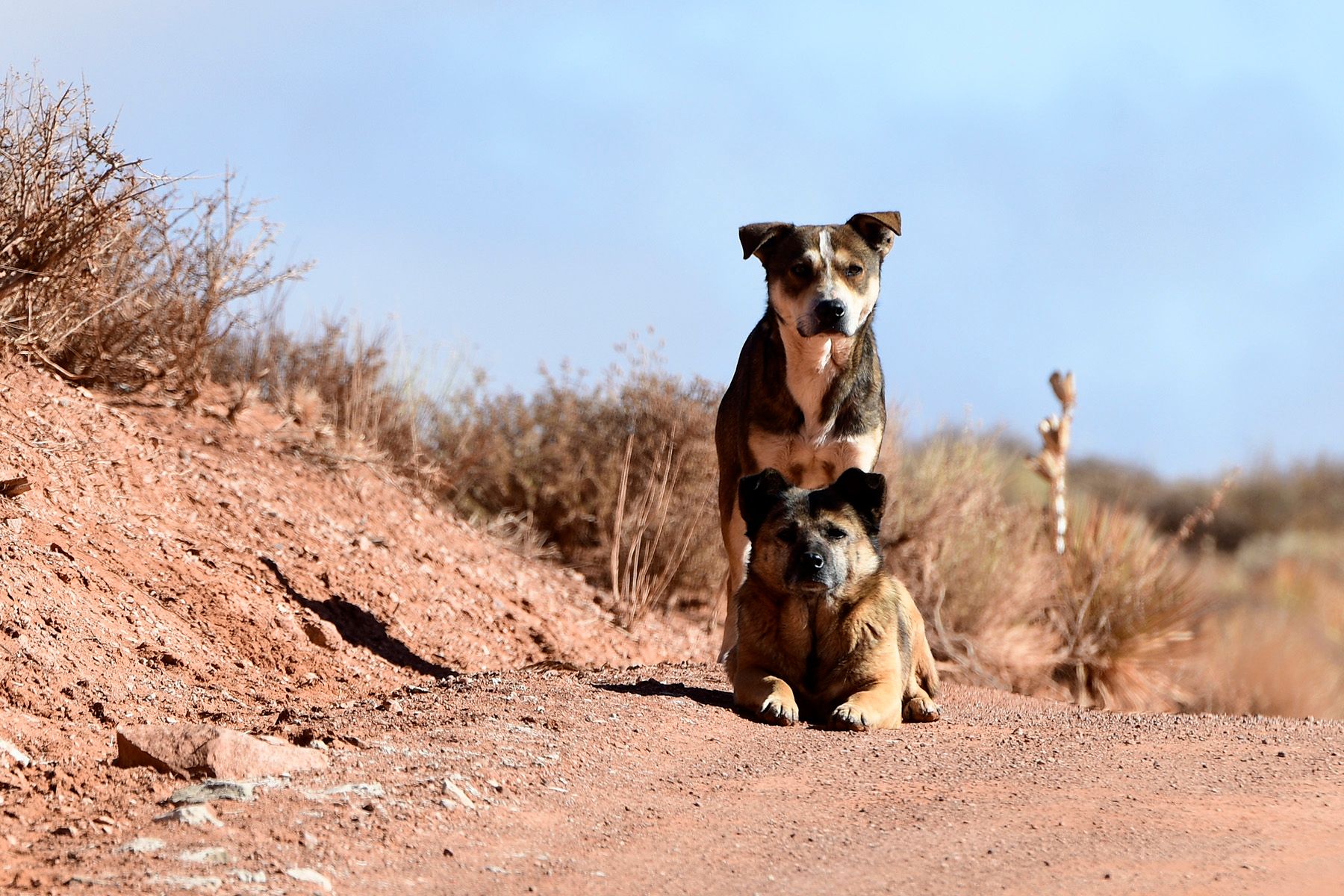
Letting Kids Run Free
When I see how some human kids are raised, it amazes me that they’re able to function at all once they reach the adult world. They seem to have every little detail of their lives carefully planned, with adults in control at all times “for their protection.” I certainly wasn’t raised that way myself. I had lots of opportunities to exhibit bad judgment early in life, and I took full advantage of them.
For example, as a 7-year old living on top of Seattle’s Queen Anne Hill, I and my 5-year old brother Greg were taking swimming lessons at the YMCA downtown at 4th and Marion. One day, Mom dropped us off for our lessons with bus fare, then went home to take care of our younger brothers Ken and Brad (aged 4 and 2). After our lesson, I picked out a bus, which happened to be the wrong one, and we climbed aboard. I realized our mistake when we passed the University District heading north. We didn’t have money for another bus fare, but I explained our situation to the bus driver and he gave us transfers, then dropped us at a spot where we could catch a bus back home. Mom was worried when we weren’t home at the usual time, but all’s well that ends well.
I think Mom got that laissez-faire approach from her parents, when she was growing up on a small farm in rural North Dakota. And Grandpa and Grandma were still giving kids that sort of freedom when I was growing up, a generation later. As a typical example, I have fond memories of the first time Grandpa gave me and Greg the keys to his pickup truck and a .22 rifle with a box of shells, and told us to go have fun out in the hills west of town (Forbes, ND). He told us of a few good spots for gopher hunting, and reminded us to be back to town before it got dark. I was 12 years old, and Greg was 10. We had a blast.
I’ve practiced that same sort of freedom as an adult, and by that I mean the freedom to just try things and see how it goes, without labeling very many activities as “off limits” or “dangerous.” For example, in my travels I like to drink the local water and eat food purchased on the street, and I’ve done so in many different countries. I’ve only been hospitalized once for that habit, and I like to think that it’s part of the reason I almost never get sick, because I’ve built up a strong immune system over the years. My doctor assures me, in the spirit of correlation does not imply causation, that there’s no scientific reason to believe that my good fortune regarding colds and flus and intestinal distress has anything to do with what I’ve put in my body, but I do. Hey, I’m also free to believe whatever I want.
Letting Dogs Run Free
It stands to reason, then, that I’d probably be a pretty permissive parent if I had kids. I don’t have kids, but in raising dogs the pattern has certainly held; I’ve never been one to show off how well my dog heels, comes, or stays.
There’s a school of thought among many dog owners, especially here in the US, that dog training is an important aspect of owning and raising a dog. The premise is that for your dog’s happiness, peace of mind, and quality of life, you must train your dog. Your dog is like a child, unknowing and naïve, and you need to make decisions for it, teach it what’s safe or dangerous, and ideally you should have it under constant voice control, for its safety as well as your own.
As is probably obvious, I have some doubts about those claims. Sure, if you don’t train your dog then he probably won’t come reliably when called, or stay when you tell him to stay. But those things don’t really interest me much. I’m more interested in how well my dogs get along with people and other animals, whether they’re ever fearful or aggressive, whether they accept and respect my authority, and so on.
With Jamie and Alice, we’ve done something I never quite took to the same extreme with any other dog I’ve had: we have made no effort to train them at all. For the first few months we had Jamie, I kept pretending I was going to work with him (after just a few more cute puppy photos!), but never got around to it. And then as he matured, he started to settle into a rhythm of behavior that I really liked. He was playful but controllable on the leash, well behaved in a wide variety of situations, and a joy to be around. I had no frustrations and no complaints, so why change anything?
That was the end of any plan for Jamie’s formal education. We got Alice nine months after Jamie, and with her I never even pretended.
They both knew “sit” when we got them at 8 weeks, and Jamie attended a single puppy training class with me at age three months (let’s just say we quickly figured out it wasn’t for us). Megan has taught both of them the soft bite, quite effectively, but we’ve never worked with them on any specific commands, although they’ve learned many words anyway, as dogs tend to do. And I think they know even more gestures than words. For example, I can pat gently on any surface up to about 5 feet off the ground, and Alice will leap up onto it to pose for a photo. Handy, that.
Speaking of dogs running free, below is one of my favorite photos I’ve taken of dog behavior. It’s a courtyard in front of a church in Kiev, Ukraine, in the spring of 2007. These seven dogs showed up (a pack of strays, I assumed, although I don’t know), and the brown and white one in the middle was clearly in charge. He lay down on the grass, and the other six lay in a circle around him. I snapped several photos, and this one is when the alpha male got up to turn around and lay in a different position, but none of his team members moved. Also note how the two closest to me are eyeing the big guy with a camera who has come near the pack. If you’re wired like me, a scene like this can give you goosebumps.
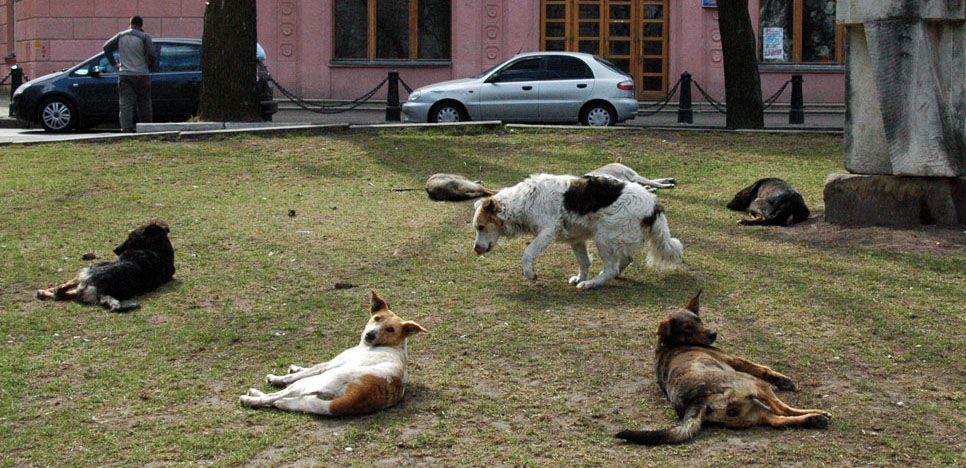
Training: what we do do
There are things we do that probably function as “training” in some sense of the word, even if we don’t think of them in those terms:
- We avoid showing any fear or shock around them, or raising our voice for any reason other than fun. In particular, we strive to minimize how often we’re in the mode of telling them “be afraid of that!” That happens maybe once a month in our lives, if that often – and I have the sense many people yell that sort of thing at their dogs many times a day.
- We don’t “correct them” when they’re hard on each other. We believe they know more about how dogs should interact than we do, so we just let them go. Many times when Alice was a puppy, Jamie was so rough with her that I think most people would have stepped in, but we never did. They have a gentle loving relationship now as adults, so it looks like Jamie knew what he was doing.
- We let them take risks and learn on their own, in countless ways. We let them play with small objects like golf balls, even sharp objects like bone slivers. We let them walk up to the edge of cliffs or raging rivers. We don’t let them run off-leash near cars, which is one exception to that approach. I have no doubt that dogs can learn to be smart around moving vehicles, just as they can learn to be smart about pretty much anything else, but our dogs have never learned those lessons so we protect them from cars.
- We give them very few treats. In fact, we happen to be 100% out of treats for the last week or so, which isn’t unusual. We do give them bones quite often, but the concept of “do this and you’ll get that as a reward” is entirely foreign to them.
- We pick them up often, and we also get on top of them and hold them down pretty often. So they know we’re bigger and stronger than they are, and they accept that.
I can’t claim to know whether these habits had anything to do with it, but it’s clear that Jamie and Alice have grown to be very accepting and fearless dogs. They don’t bark at vacuum cleaners or car washes, they even enjoy watching fireworks, they get along great with other dogs, and they rarely show fear or aggression. For example, in hundreds of dog park visits they’ve never been involved in a fight or ugly confrontation of any kind — when another dog acts aggressive, they just move along.
I also feel they have good judgment, and I trust their judgment so I don’t spend time worrying much about how to control their environment. I’ve probably misled a bunch of folks on Facebook by posting cute photos of Alice shredding books (books we’ve made it clear she can have), but overall Jamie and Alice are by far the least destructive sled dogs I’ve ever had. They don’t seem to have the nervous energy that I’ve seen in many other dogs.
One good example of how much I trust their judgment can be found in how I handle my camera around them. Nearly every day, they spend hours alone in the truck with my camera on the floor, easily within reach. They’ve occasionally shredded coffee cups or other throw-away items during those boring hours of waiting in a parked vehicle, but they’ve never touched my camera, even though it surely smells strongly of my hands. I believe that they know it’s mine, and that it’s not a toy for them to play with. Who knows, that could be anthropomorphism on my part, but whatever the reason there’s a consistent pattern of behavior there, and I never hesitate to bet my own money (in the form of an expensive camera) that the pattern will continue.
That said, I wouldn’t leave a bowl of M&Ms or antifreeze out around the house. I think they have good judgment, but they’re also free spirits with limited common sense in some areas, just like me.
Your Mileage May Vary
We’re happy with our zero-training lives with Jamie and Alice, but I am not advocating anything here – just sharing our experience. I don’t think training is bad, and I have sincere respect for many friends who have very well-trained, happy and healthy dogs. I’ve always found dog training a bit tedious myself, though, and with Jamie and Alice I’ve decided that I don’t need to pretend to be taking it seriously, or work on it for appearances. My dogs don’t know any explicit commands, but we have great fun together all day long, and we’re living our lives on our own terms.
There are probably many scenarios in which our approach wouldn’t work very well. We structure every day around spending time with the dogs, we have no children or elderly adults in our home, we have a fenced yard and lots of remote wilderness off-leash options nearby where we rarely run into any humans or dogs at all, and Samoyeds are a sturdy breed that isn’t in much danger from other dogs, as well as a smart breed that can figure things out very well on their own. I don’t know if it’s generally true of Samoyeds or just something we lucked out with on Jamie and Alice, but they also very rarely get sick or throw up.
If any of those factors changed, we might need to take training more seriously.
There are also a few things I like about Jamie and Alice’s behavior that may or may not be the result of how we’ve raised them, and we’ll never know for sure. Enjoying fireworks, for example. My brave and strong Malamute Mia was deathly afraid of fireworks many years ago, so I can’t say that I know some way to make a dog not fear loud noises. But I do know that we absolutely never react to fireworks with gasps or oohs and aahs, and I think doing so may make it harder for a dog to be calm around them. Last summer, we were parked along a road in Idaho watching fireworks on the 4th of July, and a car full of kids pulled up next to us. The kids got out and started screaming and squealing at each explosion, and Jamie and Alice, apparently picking up on the sudden excitement in their previously calm evening, started barking frantically. We packed up and quickly drove away. (Yes, I realize that’s not really an option if they’re your screaming children.)
One slightly darker possible explanation for why Jamie and Alice are calm about fireworks is our home’s proximity to the Rainier Valley area of Seattle, where gunshots are unfortunately not rare at night. We’ve heard many gunshots from our house – has hearing the occasional loud explosion at night, ever since they were little puppies, acclimated Jamie and Alice to the concept? Who knows?
Jamie listening to fireworks
An unexpected aspect of Jamie and Alice’s behavior is the ways in which they act “better trained” than other dogs that I’ve had that I actually worked with. For example, they understand the concept of going back on-leash when we’re out hiking or at the dog park, and when I take the leashes from around my neck (where I always carry them) and call to them, they trot up to me with a smile and let me put them back on the leash. Or the way they handle stairs: when I’m walking them on leash, they always stop and wait for me to take the first step before starting down a flight of stairs. If you saw it in action, you’d incorrectly assume that we’ve worked on that concept, but it’s something they just decided to do on their own.
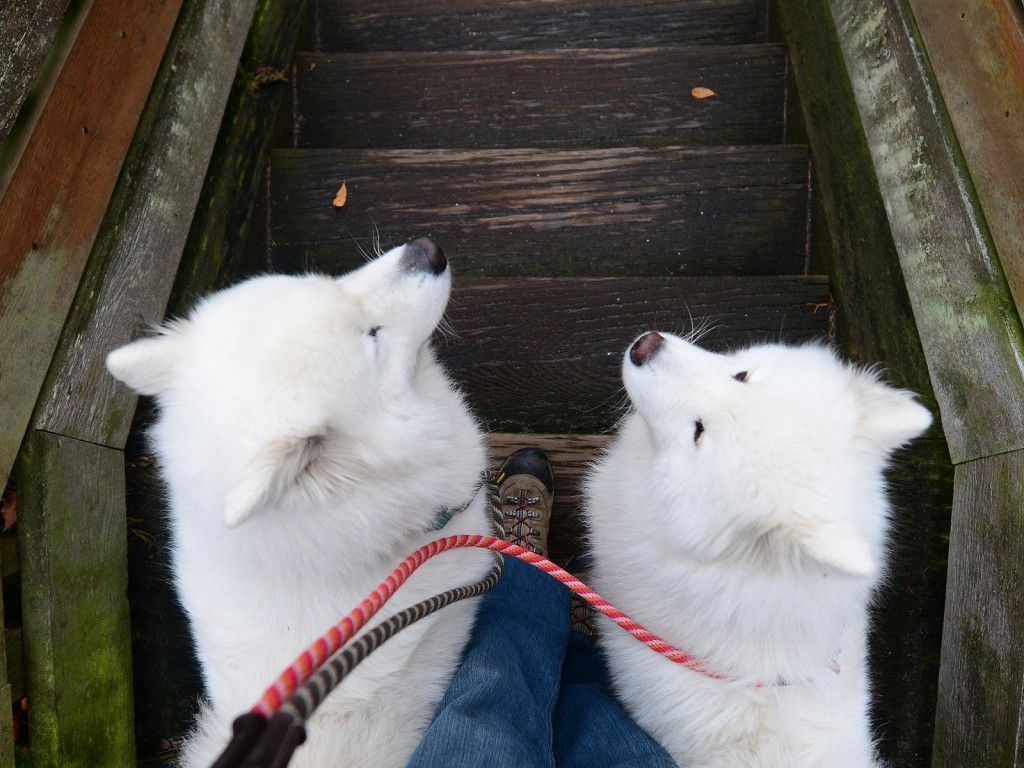
One interesting incident occurred during Thanksgiving 2012 at my Mom’s house. My nephew Van started a game of “truth or dare” with us, and I dared him to lay on the floor with a piece of turkey in his mouth, where the dogs could get it. Van was a sport, and Jamie and Alice gleefully grabbed the turkey from his mouth.
Then Van decided to one-up me, and he dared me to lay on my back with several pieces of turkey on my chest. I did it, and Jamie and Alice just stared at the turkey from a couple feet away – they wouldn’t take it off my chest, even when I tried to call them to me. I had to hand them pieces (or hold the turkey in my mouth and call to them) to convince Jamie and Alice that it was OK.
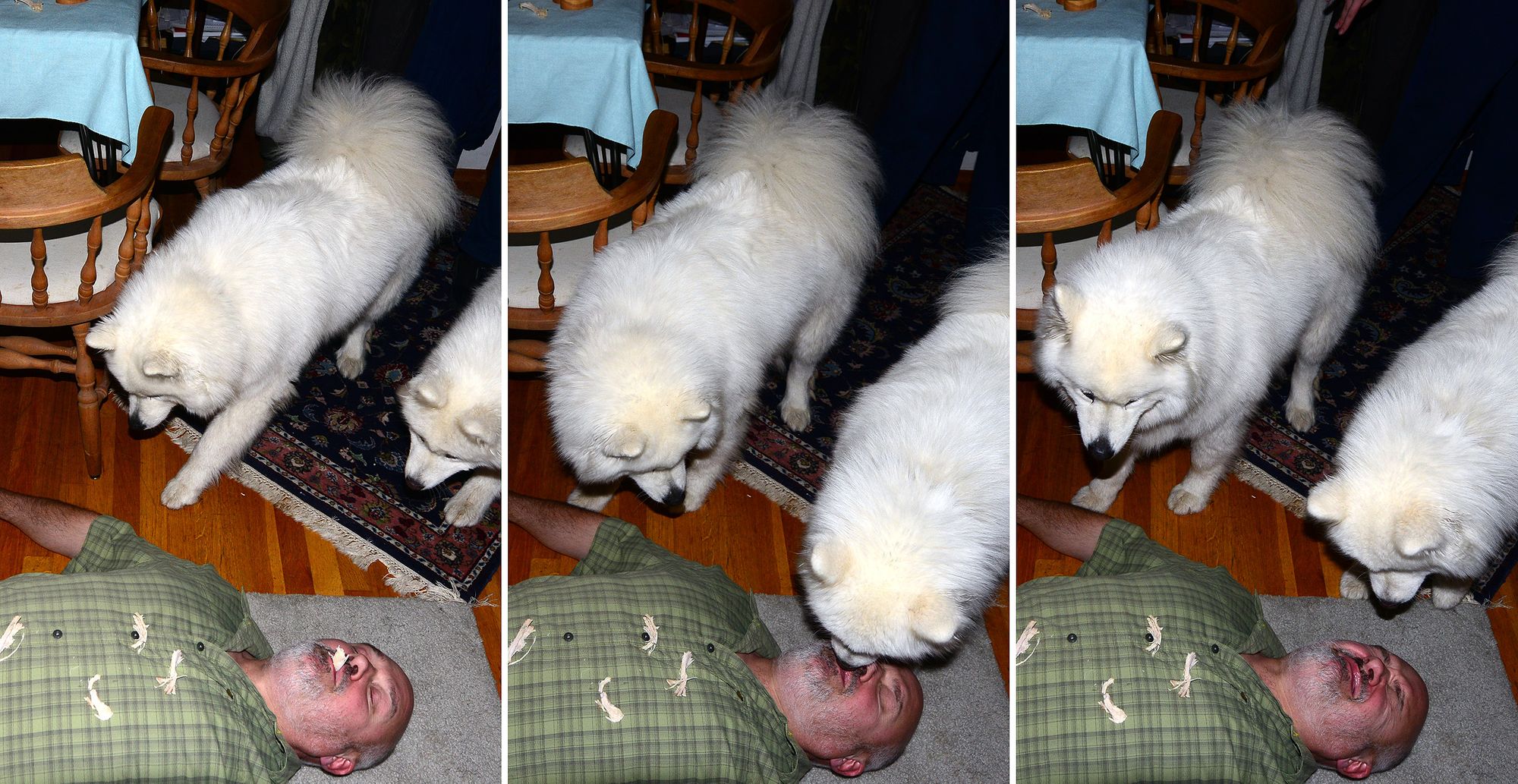
I’ve heard people say that a dog will not respect you unless you train it, but these sorts of experiences have convinced me that with dogs, just as with humans, respect is a more subtle concept than that. I feel that Jamie and Alice have clear respect for us and understand our respective roles in the pack, and it’s certainly not due to any training activities we’ve done together.
Ironically, Jamie and Alice are the only dogs I’ve ever had who elicited so many “what well-behaved dogs” comments from strangers, and they’re also the only dogs I’ve ever had that never had any training at all. Correlation, if not causation.
Hunter/Gatherer Child Rearing
I had thought all of this was just my own silly way of looking at life with dogs, but then last year anthropologist Jared Diamond (author of “Guns, Germs, and Steel,” one my favorite books) published his latest book The World Until Yesterday: What Can We Learn From Traditional Societies?. I’ve just finished “The World,” and there are many passages in it that made me think of how we’ve raised Jamie and Alice. A couple of examples …
“… modern societies have converged on a small range of child-rearing practices that by historical standards are unusual. Those practices include systems of school education administered by a state (as opposed to learning as part of everyday life and play), protection of children by police and not just by parents, same-age playgroups (as opposed to children of all ages routinely playing together), children and parents sleeping in separate bedrooms (as opposed to sleeping together in the same bed) …”
“ … among African pygmies hitting a child would be grounds for divorce. There is no physical punishment allowed at all in these societies. If a child plays with a sharp knife and waves it around, so be it. They will cut themselves on some occasions, but society figures it is better for the child to learn the hard way early in life.”
He tells stories of hunter/gatherer societies where small children are free to play with fire, or where children go out alone hunting and fishing, with no adults to protect them from dangerous animals and dangerous conditions. And he describes the disfiguring scars found on some adults in those societies, the consequence of errors in judgment as small children.
“Some kids get burned and some kids have serious accidents,” he notes, “but the result by and large is that people grow up to be self-confident and responsible.”
Good judgment comes from experience, which comes from bad judgment
Alice has some large scars on her neck, although her thick Samoyed fur covers them up. As her longtime friends know, she sustained a brutal injury when a stick plunged through her mouth and down into her neck at age 8 months. She had multiple surgeries, and it took months to clear up the situation. We didn’t see the original incident happen, but it was at the beach and she must have been running or leaping with a stick in her mouth.
Now that she’s 100% recovered, we see that injury as an intense learning experience for her, and we believe that she knows far more about the dangers of running with a stick in her mouth than we do, or many other dogs do. She suffered for months, starting the instant it happened, and I’m sure she is very unlikely to do the same thing again.
In Jared Diamond’s book, he describes a mother in a hunter/gatherer society who allowed her 2-year-old to play with a sharp knife, and how she even picked up the knife and handed it back to him when he dropped it.
On that note, I’ll wrap this up with a photo from yesterday at the beach: Alice leaping from log to log at high speed with a stick in her mouth, a stick I gave to her. Go Alice!
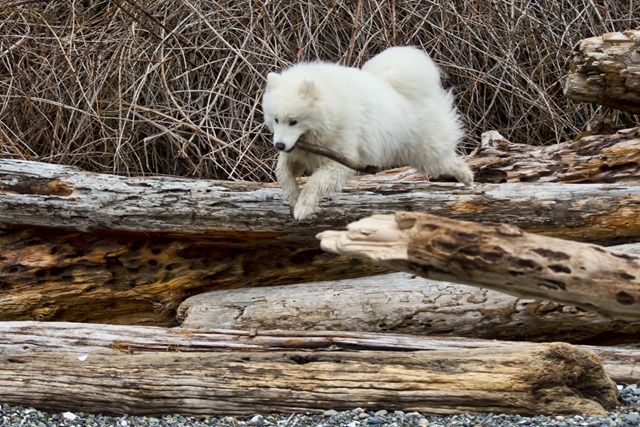
Addendum: Alice lived for over a decade after this blog post, never again suffering any type of serious injury. During that time, she visited 25 states across the US and traveled across much of western Canada as well, running free in a huge variety of environments from ocean beaches to rugged rocky mountain peaks to deserts, swamps, and forests.